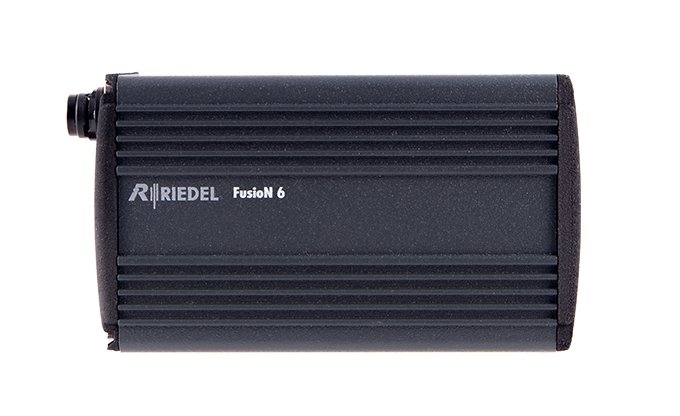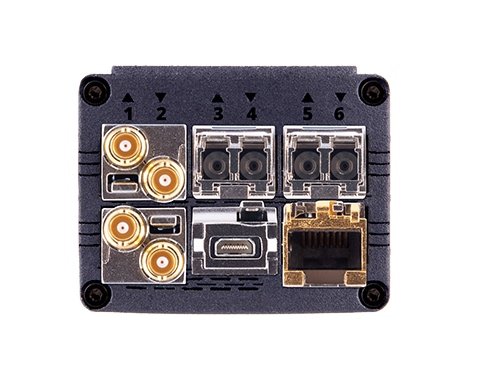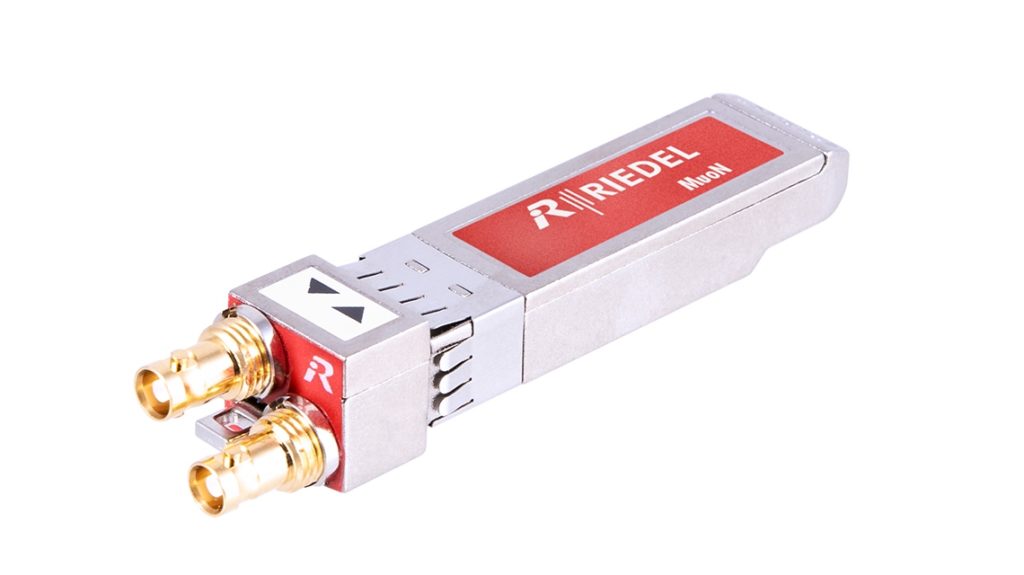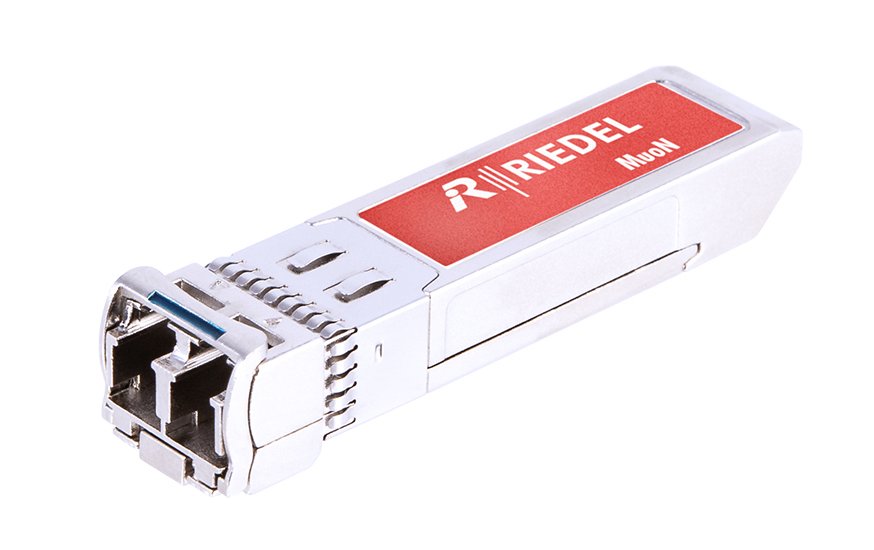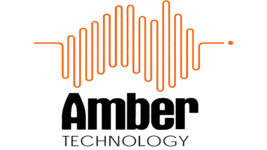News
27 Jul 2020
SDI vs IP? Riedel Builds Bridges with MediorNet

Subscribe to CX E-News
With the recent release of 13 new hardware devices and nine new software apps in Riedel’s MediorNet series of video networking devices, the German comms legend is now an even bigger player in video distribution and processing.
The acquisition of Canada’s Embrionix in 2019, experts in the manufacture of SFPs for handling SDI and video over IP, has put a rocket under Riedel’s video line up. I interviewed Chris Johnson, Director of Riedel Communications Australia, about the expansion of their video toolkit, the future of video over IP, and the new world of software-defined hardware in AV.
Chris, most people know Riedel as a comms company, but video has been a significant part of your offering for a while now, hasn’t it?
That’s right – the first MediorNet device was released in 2009, so video has been a big part of our business for over ten years now. We now like to think of ourselves as a real-time networks company; voice communication is part of that, and so is video.
We’ve been watching and been active in the transition to IP video. We’re particularly interested in the development of SMPTE 2110 (essentially the IP equivalent of SDI) as the ecosystem matures. We’ve been front-footed in contributing to standards development, and in running the ‘plug fests’ that happen around the big tradeshows.
Some say that the move to video over IP has already happened, but it’s not the case; the reality in both installations and live productions is that it’s a hybrid world, with SDI and IP used simultaneously.
What are the barriers to video going totally IP?
Basically, it’s harder to turn video into IP than audio, which you could fairly say has made the transition already. When audio went IP, we weren’t pushing the boundaries of switching networks. Honestly, you could do a lot with Dante on even a humble 100MB switch.
When we started to look at video over IP a decade ago, the really big switches that did the specific things we needed just didn’t exist, and even now the portfolio of video capable switches is still very small. Not to mention that when we look at an SDI cable, its easy to see only the video, when in fact there is lots of audio and data in there too which needs to be considered.
So Riedel’s not championing one workflow over another?
We see our video offering as both IP and SDI. We’re not one of those manufacturers that force their customers to go one way or the other. There are times where IP makes sense, and times where it doesn’t. Events might be more suited to baseband workflow because its quick, plug and play, and easy to troubleshoot.
In a facility, IP might make more sense because we want converged infrastructure and the ability to move signals around at will. So now we have a video portfolio that’s SDI, IP, and all the bits in the middle, which is the reality of the landscape. If you go into a big IP facility, you’ll still find SDI cables.
A good real-world example is Hillsong Conference, which has a serious video requirement. The most fundamental need for the video system at Conference is that it goes from being in a truck, to pushing signal around the venue, in four hours.
MediorNet SDI is the right solution for that, and will continue to be for the immediate future. IP will one day be that simple and user friendly, but it isn’t yet. If you want plug and play, there’s a bunch of development that still needs to happen in video over IP.
Another factor is that the cost of 4K infrastructure can be astronomical. You buy cables to run HD for 100 metres for not much money, But that’s much harder for 4K signals, so there’s a necessity for tools like MediorNet when dealing with UHD workflows. If you need half baseband and half IP, no worries.
We’re about the bridge. If you own a fleet of 4K 12G SDI cameras, you’re not going to spend seven figures to replace them because they’ve got the wrong connector – that’s just commercial reality. Riedel see ourselves as being able to build our customers an ultimately flexible infrastructure.
Why did Riedel decide to acquire Embrionix?
Embrionix shares some of the same DNA as Riedel – it was started by a small team, and developed in a niche in broadcast. Their video over IP products are incredibly innovative. We recognised that the technology they had was a great fit with what we’d built in MediorNet, but on the IP side instead of the baseband side.
We moved to acquire them at the end of last year. The meeting of our companies’ respective technology and culture makes it feel more like a merger than an acquisition.
It’s amazing what Embrionix can get into an SFP. They’re doing multiviewers in an SFP. It wasn’t that long ago that doing multiviewers in a single rack unit was an innovative idea. With our MediorNet MuoN SFP, we can get 32 multiviewer heads into a single rack unit, and each one can be 16 PiPs. It’s amazing.
Most of the MediorNet family, excluding the JPEG encoder/decoders, does not use compression. Why?
Our aim is to keep everything uncompressed until the end of the signal chain, to avoid creating artefacts. Also, it doesn’t matter how good your compression is, it is by definition slower than not compressing, because there’s a process that has to happen. So staying uncompressed helps keep latency as close to zero as possible.
Compression is also expensive; a pretty powerful chip is needed to do it, and that adds cost to a product.
The MediorNet products are software-defined. This is a new paradigm in our industry; what’s led this development?
While software-defined is pretty new for our industry, it’s nothing new to the world in general. For example, we don’t buy ‘accounting’ or ‘design’ computers, we buy a computer and install whatever software we need.
MediorNet originally started as hardware-defined, card-based, and modular; there were multiple parts and multiple SKUs. Then when we introduced the MicroN, we brought the software defined concept to the product, and we’ve continued that through our whole product lineup.
When you produce something software-defined, you have just one hardware SKU. The customer then buys the functionality they want, giving them a future proof investment Apps control all of the new MediorNet products. You decide what’s running on your SFP and what it’s doing today.
Once your video is converted to SMPTE 2110, we’re in the processing space. From there, you can switch, route, create a multiviewer, take signals off the network, put them back on the network, plug into a monitor. We can do up, down, and cross conversion. Whatever you need, ‘we have an app for that’!
CX Magazine – July 2020
LIGHTING | AUDIO | VIDEO | STAGING | INTEGRATION
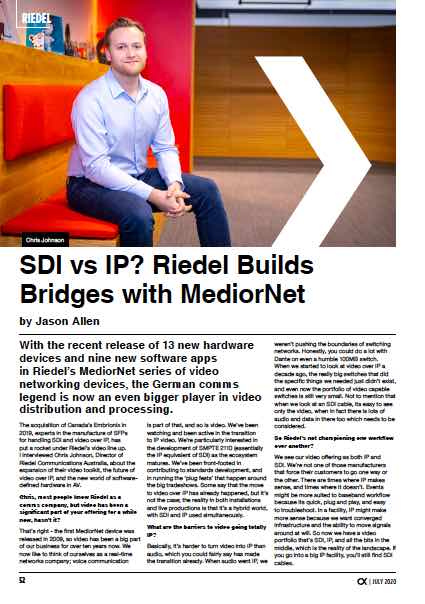
Entertainment technology news and issues for Australia and New Zealand
– in print and free online www.cxnetwork.com.au
© VCS Creative Publishing
Subscribe
Published monthly since 1991, our famous AV industry magazine is free for download or pay for print. Subscribers also receive CX News, our free weekly email with the latest industry news and jobs.



